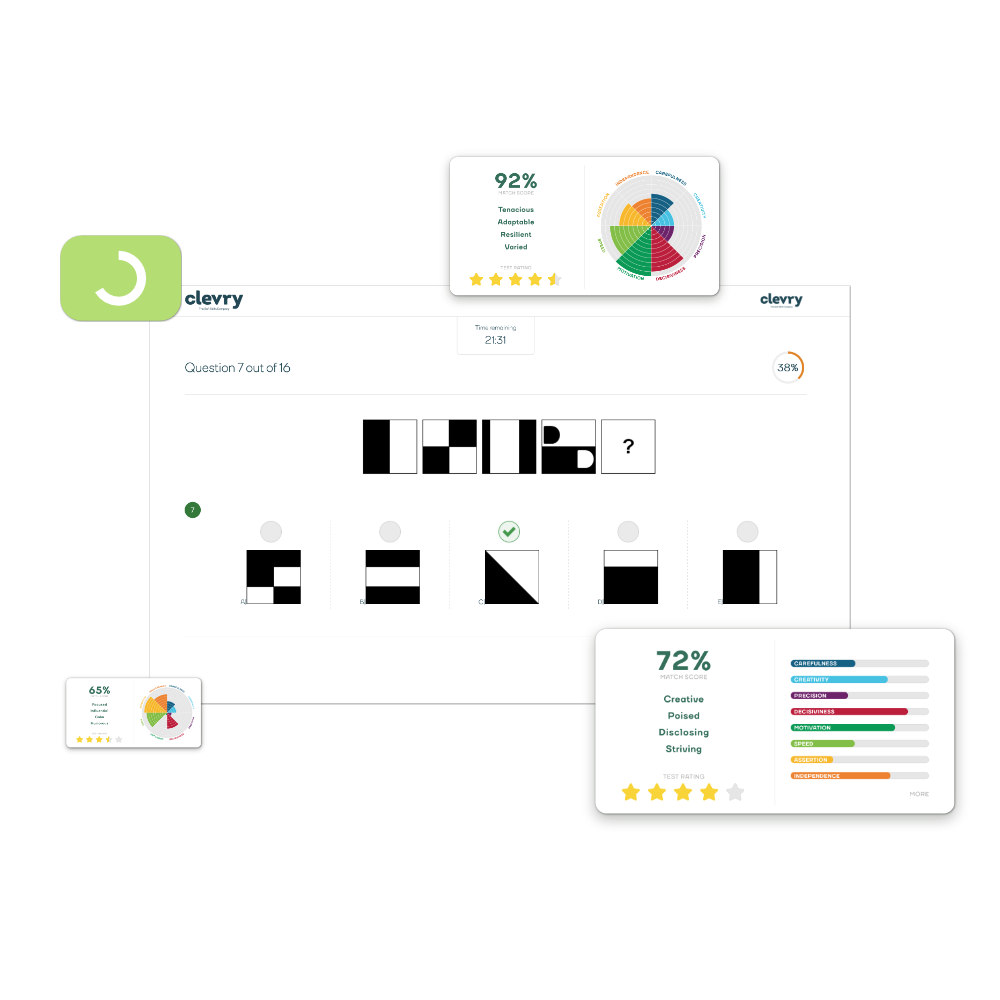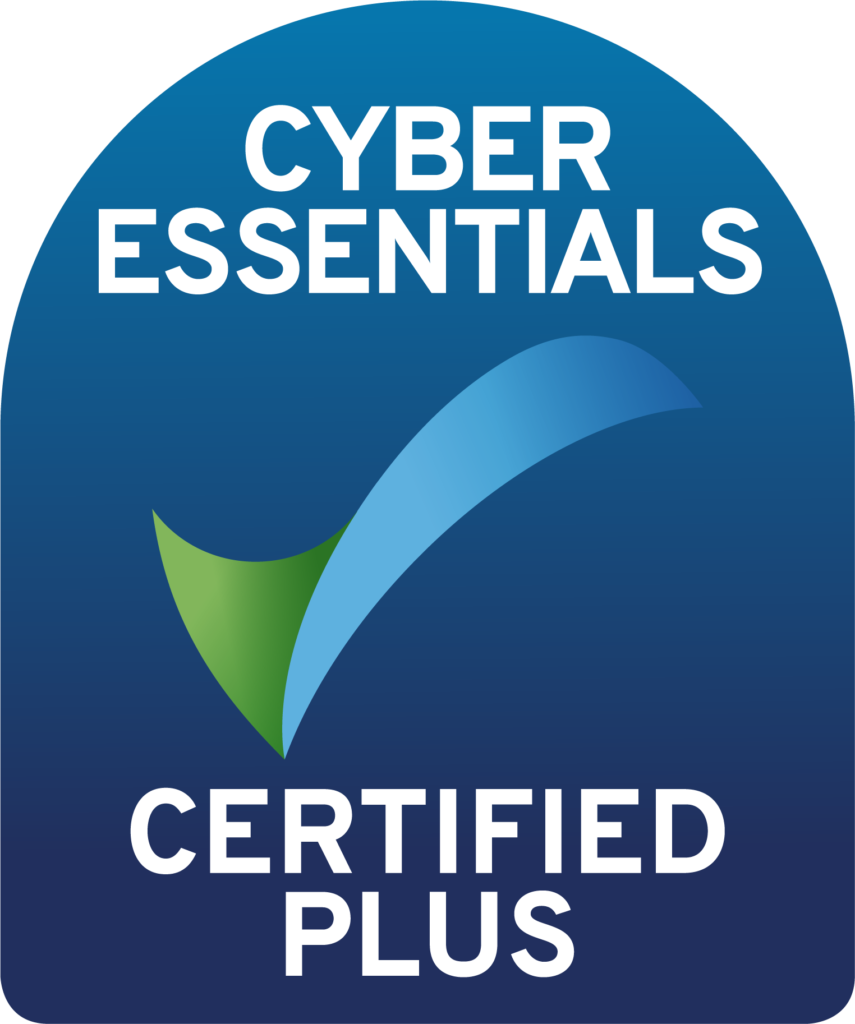Resources
How to run a virtual assessment centre
A guide to designing & delivering a virtual assessment centre
Home » Platform » Assessments » How to run a virtual assessment centre
When designing and delivering a virtual assessment centre, it’s important to follow best practice guidance.
This can help organisations increase the validity and effectiveness of their assessment process whilst ensuring that candidates have a fair and positive experience.
The following guidelines have been adapted from the British Psychological Society’s Standards on Assessment Centres, the International Taskforce on Assessment Centre Guidance (2015), and the International Test Commission’s (2005) International Guidelines on Computer-Based and Internet Delivered Testing, combined with our own Clevry consultants’ professional experience.
Planning your virtual assessment centre
Choose a service provider
The service provider will be responsible for designing and delivering your Virtual Assessment Centre. The service provider may be an internal employee or an external contractor (such as Clevry).
When choosing a service provider it is important to consider their competence in designing and delivering assessment centres, and their compliance with legal and regulatory requirements.
Establish soft- and hardware requirements
Ensure that the software and/or hardware you wish to use are adequate for hosting the Virtual Assessment Centre so That it can be delivered consistently and smoothly.
It must be sufficiently robust to deal with potential system failures. You should also take measures to minimise the risks of hacking (to avoid hackers gaining access to test materials and candidate scores) and ensure that the data is backed up. Consider whether any additional software is needed for interactive activities, e.g. Google Hangouts or Zoom.
A benefit of using a service provider such as Clevry is that all assessment processes can be managed on a single platform with the option of adding your own branding.
Clevry is a secure, ISO 27001 certified, and GDPR compliant platform that ensures your data is safe and secure. Consider integrating the Virtual Assessment Centre with your Applicant Tracking System (ATS)
This can help provide a more seamless experience for your hiring managers and candidates. Clevry, for example, integrates easily with a range of ATS providers.
Define the purpose of using a Virtual Assessment Centre Assessment centres can be used for a number of purposes, including assessment and selection, professional development, and succession planning. Thus, it is important to consider whether a Virtual AC is an appropriate method for your particular purpose.
The purpose will influence how the Virtual Assessment Centre is designed and delivered, as well as how the personal data of candidates is used.
Clearly outline your assessment needs
Understanding the assessment needs and the context in which the assessments take place is a crucial prerequisite for designing a Virtual Assessment Centre.
This information should be shared with your service provider as early as possible.
Decide between using your own, bespoke, or off-the-shelf content
Your existing assessments can be adapted and hosted on a virtual platform. If you decide to move your existing assessment centre materials online, you need to ensure that you can demonstrate evidence of equivalence.
This means that the online version correlates with your traditional pen-and-paper assessment, has comparable reliability, and can predict external criteria (such as job performance).
If you decide to use an external service provider, like Clevry, you will also have the option of choosing between off-the- shelf materials and or creating a bespoke Virtual Assessment Centre.
There are advantages to either approach, so ensure that you choose the one that is the most suitable for your recruitment needs. Clevry’s business Business Psychologists can help you with this.
Use psychometrics
One of the benefits of Virtual Assessment Centres is that you can run them as often as you would like, even daily. However this also means that you may receive a large volume of candidates who need to be assessed.
Psychometrics (e.g. cognitive ability tests and personality questionnaires) and Situational Judgement Tests (SJTs) can be used to sift candidates during the shortlisting stage to r educe the number of candidates participating in the Virtual Assessment Centre.
Psychometrics can also be used within the Virtual Assessment Centre to uncover competencies that are more difficult to observe in other activities without the face-to-face elements.
Additionally, our Personality Questionnaires have the option of generating a range of insightful reports, such as our interviewer report, which assessors can use to better structure their interviews with candidates.
Designing a virtual assessment centre
Conduct a Job Analysis and Competency Modelling
The job analysis helps you identify the responsibilities and duties of a specific role, and what knowledge, skills, abilities and other attributes are necessary to perform in the role.
Competency modelling is useful for uncovering the assessment criteria; it will help you describe the competencies you wish to assess and create indicators for what good and poor performance looks like.
It’s important that the assessment criteria are described as behaviours as these will be used to create the positive and negative performance indicators that will guide assessors in their evaluation.
Map the Competencies with Virtual Assessment Centre Activities: Validity and Reliability
The composition of the Virtual Assessment Centre will affect its overall validity. Firstly, ensure the competencies you have identified predict performance in the role. The job analysis will give an indication of this, however you may want to conduct your own statistical analyses and refer to research literature.
For example, research suggests that some competencies (e.g. problem-solving) are generally better predictors of performance than others (e.g. drive).
Secondly, ensure that the methods (i.e. the activities) you want to use to measure the competencies are valid and reliable by examining whether they a) capture the desired competencies, b) predict job performance, and c) accurately measure what they intend to.
Multiple Assessment Methods
A Virtual Assessment Centre would not be an assessment centre unless it included multiple assessments.
A variety of activities should be used to collect evidence about candidates’ performance against the different competencies.
At a minimum, this could include a structured interview
and simulation exercises. Simulation exercises allow assessors to observe candidates’ behaviours as they would be performed in the role.
Examples of these kinds of exercises include in-tray or fact-finding exercises, presentations, analysis exercises, or group discussions.
The use of technology in the Virtual Assessment Centre can actually increase the perceived similarity between the assessments and the real work context.
For example, tasks that would usually be performed online, such as responding to emails, can easily be simulated in the in-tray exercise.
Potential limitations
Bear in mind that some competencies, especially those usually assessed in group discussions (e.g. social skills, influencing others), are more difficult to observe without face- to-face elements.
In some cases adjustments can be made to traditional exercises to make them suitable for virtual assessment (please see the following section), but in other cases the competencies may need to be assessed outside the Virtual Assessment Centre, such as through psychometric assessments.
Reduce the time duration and group sizes
Keep the event short to maximise engagement. Candidates may feel tired or restless after sitting down in front of a computer screen for a prolonged period of time.
You should aim for maximum 3 hours of assessments, including breaks. Within this timescale it may be appropriate to aim for 2-3 activities.
An advantage of running a Virtual Assessment Centre is that it is possible to spread out activities across several days to avoid lengthy sessions. This helps if candidates are required to complete a large number of assessments.
Group discussions are a common assessment centre activity that may be difficult to deliver online without the face-to-face elements. While we do not necessarily recommend that you avoid using them, you may have to make some adjustments. For example, you can reduce the group size from 6 candidates to 3 or 4 candidates.
Identify assessors and training needs
The assessors will evaluate the candidates’ performance against the competencies. Ideally they should be a diverse group both in terms of their personal characteristics (e.g. age, sex, and ethnicity) and experience. To ensure that the process is robust, assessors should be rotated across the candidates so that no single assessor evaluates one single candidate.
All assessors need to be appropriately trained to use the assessment platform as well as the various methods within the assessment centre, including the Observe, Record, Classify and Evaluate (ORCE) process. You may also need to train the assessors or additional personnel to participate in role play exercises.
Prepare your Virtual Assessment Centre materials
Using a Virtual Assessment Centre eliminates the need for paper forms. The materials used in the assessment activities should be built into the system and hosted within the platform itself.
To protect the test materials, steps should be taken to ensure that materials cannot be downloaded, printed or copied and pasted.
Timetabling and scheduling
The timetables for Virtual Assessment Centres can be more flexible than for traditional assessment centres as candidates are not required to complete their assessments in allocated rooms at specific times.
The timetable should outline the activities candidates are required to complete, and by when. For interactive exercises, such as interviews, assessors can indicate their availability on the platform, and candidates can then be invited to choose a time-slot that suits them.
When using a mixture of unscheduled and scheduled activities, it is important to ensure that it is clear which activities are scheduled at a specific time to reduce the risk of candidates entering virtual exercises too early or late.
Standardise your process
Try to ensure that your process is as standardised as possible. Candidates should be given the same information and practice materials, and complete the same exercises within the same timeframe.
With Virtual Assessment Centres there are several factors to consider that may affect the standardisation of your process, including:
- Equipment (e.g. computer, screen size, and sound quality)
- Internet access and speed
- Browser compatibility
- Working conditions (e.g. noise, lighting, heating, or others being present nearby)
Prepare for potential technical issues
Ensure that everyone can access the platform or software required to participate. You may want to provide an opportunity for candidates to practice using the platform beforehand.
In case technological issues do occur, be prepared to reassure candidates and consider optional methods of continuing the virtual assessment centre, e.g. over the phone.
It’s good practice to have a facilitator available to oversee the assessment process, so that candidates and assessors can contact them, e.g. via phone or a webchat, if any issues arise.
Allow for reasonable adjustments
As with any assessments, you will need to consider how you can maximise accessibility. It is your legal duty to offer reasonable adjustments to candidates with disabilities.
Reasonable adjustments may include adjusting the font size in exercises with written information, providing audio or text alternatives, or extra time.
Other considerations may include using keyboard navigation for those who are unable to use a mouse, high colour contrasts for individuals with visual impairments, and avoiding any flashing, moving or blinking content for individuals with ADHD or visual processing disorders.
Plan the evaluation
Decide early in the process how you are going to evaluate the Virtual Assessment Centre to help you improve the process in the future.
Have a clear plan for how you are going to collect feedback from candidates, assessors, role players and any other stakeholders.
Also, ensure that you have access to any data needed to calculate the costs and benefits of running the Virtual Assessment Centre.
Preparing your candidates
Provide candidates with detailed information and obtain their informed consent
Candidates should be sufficiently briefed about practicalities, the selection process, and other important information in advance of the event so that they can make an informed decision about participating.
Clevry provides client organisations with a “Preparation Guide” template that can be adapted and shared with candidates for this purpose.
Whether you use a template or not, be sure to include the information included on the following page when inviting candidates to participate in your Virtual AC.
If candidates can see how the assessments are related to the job and believe that the selection process is fair, they are more likely to hold favourable views about your company and to accept a job offer.
Check in with candidates before the Virtual AC
Check in with candidates before the session to explain the process and answer any questions they have.
This can help your candidates feel more comfortable, and ensures that they know what to expect.
You may also want to consider offering a pre-session or a five- minute-check-in before the start of the event to ensure candidates can log on to the system and navigate the platform, and to provide an opportunity for them to practice using the software.
Use this as an opportunity to troubleshoot any technical issues that arise.
During the Virtual Assessment Centre
Delivery
Virtual Assessment Centres allow assessors to manage candidates and record their observations both live and after the assessments.
In either case, the assessors should be rotated across the candidates so that each candidate is assessed by multiple assessors.
Starting the sessions
Ensure that systems of communication are in place, and be prepared to deal with technical or other issues according to your pre-agreed plan.
Personnel involved in the assessment process should maintain a record of any reported issues that arise while candidates or assessors are using the platform.
Assessors should ensure that they are available online before the start of any scheduled activities, such as interviews.
Assessing and scoring candidates
When assessing candidates, best practice is to follow the ORCE (Observe, Record, Classify, Evaluate) process so that candidates are assessed as fairly and objectively as possible.
Assessors should use behaviourally-anchored ratings scales (BARS) to score candidates’ performance on the various assessments. It’s crucial that the behavioural scoring is based on the competencies identified in the job analysis and competency modelling.
In a Virtual AC the majority of scoring might occur afterwards, with assessors accessing video recordings or written submissions via the platform after the activity has already taken place.
While scoring candidates online is more efficient than traditional scoring methods as it reduces assessor workload (and errors), it is equally important to apply the same high standards as you would in a traditional assessment centre.
After the Virtual Assessment Centre
Data Integration (Wash-Up)
Usually at the end of an assessment centre the assessors meet to discuss candidates’ performance and agree on an overall assessment rating (OAR).
This is a lengthy process, and one that is perhaps more challenging to manage virtually.
An advantage of Virtual Assessment Centres is that the
data integration can be done automatically and arithmetically, which reduces subjective bias and time, and removes the need for assessors to meet in person.
Indeed, research indicates that using a statistically calculated composite of candidates’ scores is a better predictor of future job and training performance than using the assessor-agreed OAR.
The Clevry platform allows assessors to organise and compare their notes directly on the platform, creating an effective and rigorous wash-up grid where you can observe candidates’ scores on the various competencies, as well as their overall scores.
Candidate Feedback
Provide feedback to candidates as promised. Writing a feedback report can be very time consuming. One of the benefits of using Virtual Assessment Centres is that feedback reports can be generated directly on the platform and made automatically available to the candidates upon completion.
Remember to inform the candidates about the outcomes from the assessment centre.
Evaluation
Immediate feedback on the assessment process
Collect feedback from candidates about their experiences of the assessment process and outcomes, including their reactions and perceptions of fairness.
Find out from both candidates and assessors what aspects went well, and what aspects did not. This will help inform changes or improvements to any future virtual assessment centres you run.
Further analysis and impact
The service provider can help you conduct a more detailed analysis of your Virtual Assessment Centre. This involves conducting validity and reliability analyses to demonstrate whether the Virtual AC was accurate and effective.
The analysis should also examine adverse impact to ensure no protected groups were disadvantaged, and explore any other impacts on candidates’ wellbeing as a result of participating. Finally, the costs and benefits of running a Virtual AC should be calculated.

Conclusion
In the ever-evolving landscape of talent assessment, the use of virtual assessment centres stands as a powerful tool for organisations seeking to enhance the precision, fairness, and efficiency of their selection processes.
The guidelines provided in this comprehensive guide are a culmination of industry best practices, psychological principles, and practical insights to navigate the realm of virtual assessment centres with confidence.
While this guide is by no means exhaustive, we hope it helps to give you a feel for some of the main points to consider when implementing a Virtual Assessment Centre solution.
If you would like to know more about how Clevry assessments can improve your end-to-end recruitment process then please do get in touch and one of the team will be happy to answer any questions.


